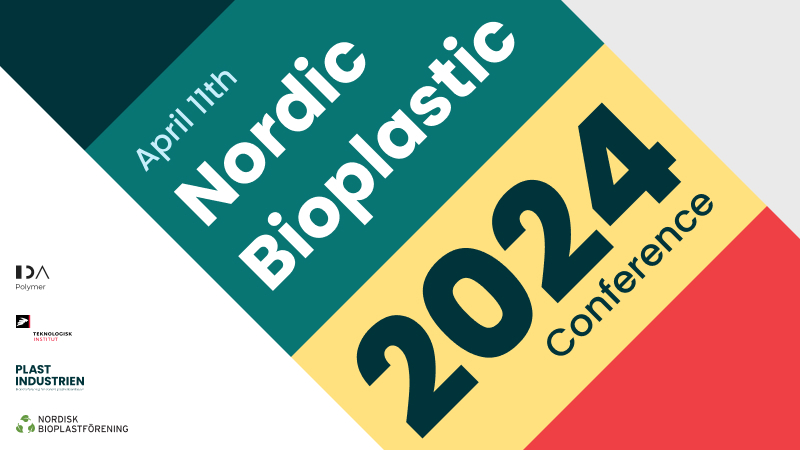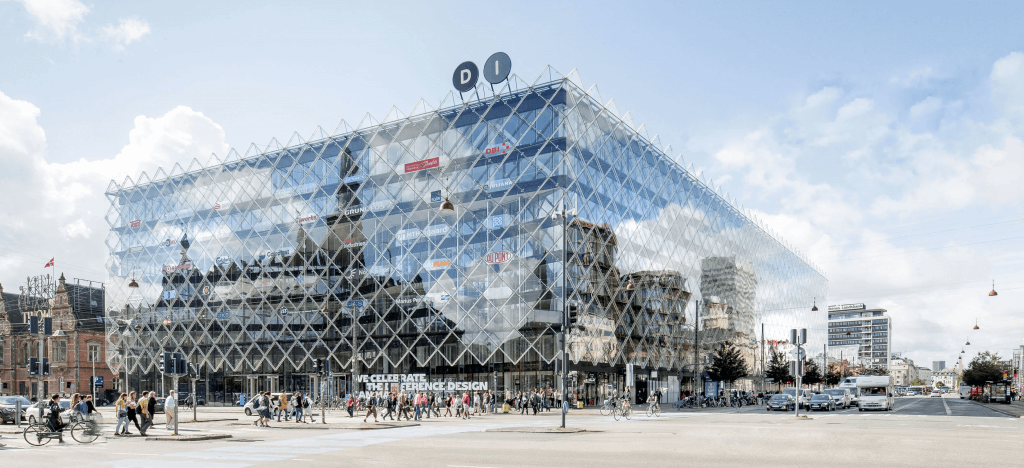Nordic Bioplastic Conference 2024 April 11th

On April 11th in Copenhagen, the Nordic Bioplastic Conference 2024 will showcase the latest innovations in biobased and biodegradable plastics. An extensive program provides the opportunity to explore the possibilities within this diverse set of materials.
This is a past event. See pictures and presentations here: https://plast.dk/2024/04/praesentationer-og-billeder-fra-nordic-bioplastic-conference/
The Nordic Bioplastic Conference 2024 will bring together experts from the entire bioplastics value chain to update the industry on developments within the field. In addition to industry case studies and market and application overviews, the event will also feature input from experts, policymakers, and consultants.
Conference program
| Time | Topic | Speaker | |
| 09:00 | 09:30 | Breakfast | |
| 09:30 | 09:35 | Welcome | Rasmus Grusgaard, The Danish Plastics Federation |
| 09:35 | 09:40 | Bioplastics explained We establish a common understanding of the terms biobased plastic and biodegradable plastics as an outset for the day. |
|
| 09:40 | 10:05 | Bioplastics at the crossroads The transition from a linear to a circular economy in Europe presents significant opportunities for the bioplastics industry, but its progress is hindered by challenges such as misinformation, communication barriers, and inadequate legislation. The industry’s response to these obstacles will shape the future role of bioplastics. |
Hasso von Pogrell, European Bioplastics |
| 10:05 | 10:30 | Material selection: The case of bio-based polymers versus the alternatives, examples in cases for infill and packaging A Danish innovation replaces shredded tires with biodegradable polymers for soccer field infill, analyzing costs and environmental impacts to forecast future material trends. |
Jan Noordegraaf, Innograaf BV |
| 10:30 | 10:55 | Trustworthy mass balance – a key to sustainable transformation Market demand for biobased and recycled materials, driven by end-user acceptance, is essential for transitioning from virgin fossil materials. Perstorp’s use of mass balance, along with collaboration with IKEA, The LEGO Group, and VELUX, showcases efforts to establish a trustworthy system that incentivizes sustainable transformation through new feedstocks and technologies. |
Anna Berggren, Perstorp |
| 10:55 | 11:25 | Coffee break | |
| 11:25 | 11:45 | VELUX needs and perspectives on mass balance VELUX aims to advance its circular economy and decarbonization efforts, that calls for clear rules and a level playing field for application of methods such as mass balance to support the transition and ensure transparency and credibility of the system that needs acceptance from all parties in the value chain, including regulatory compliance. |
Anja Gylling, VELUX |
| 11:45 | 12:05 | Life Cycle Assessments and Environmental Product Declarations: The Role of the Mass Balance Approach This presentation explores the Mass Balance Approach as per ISO 22095 in LCAs and its implications for EPDs, highlighting its current use, limitations, and future potential in enhancing transparency and accuracy in documenting environmental impacts. |
Asger Alexander Wendt Karl, Teknologisk Institut / EPD Danmark |
| 12:05 | 12:30 | Lost at Sea: Developing Biodolomer® Ocean to Combat Abandoned, Lost, and otherwise Discarded Fishing Gear Aquaculture gear contributes to 27% of marine plastic litter, creating harmful “ghost nets”; biodegradable alternatives promise to mitigate this by safely decomposing on the ocean floor. |
Konrad Rosén, GAIA Biomaterials |
| 12:30 | 13:30 | Lunch | |
| 13:30 | 13:50 | Plastic in a circular business model Exploring Circular Business Models in Plastics: A Deep Dive into IDUN’s Innovations in Bioplastic Product Design and Sustainable Practices, Including Insights on Mass Balance and Contributions from DUNI’s Food Packaging Solutions. |
Erland Riis Lavsen, Duni Group |
| 13:50 | 14:10 | Plastic from seaweed Exploring algae as a bioplastic source reveals significant advantages over traditional corn, including rapid growth for efficient production, environmental benefits through carbon absorption and support for marine life, and the ability to utilize non-arable land, presenting a sustainable and land-efficient alternative. |
Henrik Truelsen, Dansk Algeplast |
| 14:10 | 14:30 | 25 Years of ecoflex®: BASF’s Journey in Shaping the Present and Future of Circular and Sustainable Plastics Explore 25 years of ecoflex®, BASF’s biodegradable plastic, and its role in sustainability and the circular economy. Learn about its milestones, current innovations, and future sustainable plastic solutions. This session highlights BASF’s dedication to a more sustainable future through circular economy practices. |
Gijs Habraken / Afsaneh Nabifar, BASF |
| 14:30 | 15:00 | Coffee break | |
| 15:00 | 15:25 | From Responsibility to Action: Italy’s EPR Approach to Bioplastic Sustainability Italy leads in food waste management and compostable bioplastics, significantly cutting single-use plastic use. The country processes 8 million tonnes of organic waste yearly, reducing CO2 emissions and improving soil health through composting. The introduction of compostable bioplastics has streamlined waste collection and curbed conventional plastic use, supported by policies that encourage sustainable materials, resulting in a marked decrease in single-use plastic production. |
Marco Versari, biorepack |
| 15:25 | 15:45 | Enzymatic solutions for circular plastic Discover Novonesis’ (previously Novozymes) role in advancing a circular plastic industry through enzymatic solutions. This session highlights their breakthroughs in plastic recycling, biodegradation, and bioplastics, and their commercialization efforts with partners. Learn about their sustainable biosolutions impacting various sectors. |
Anne Stenbæk, Novonesis (prev. Novozymes) |
| 15:45 | 16:05 | Bioplastics at Ambu | Tenna Brandt Nielsen, Ambu |
| 16:05 | 16:10 | Conference Wrap-up | Rasmus Grusgaard, The Danish Plastics Federation |
| 16:10 | 17:00 | Networking Drinks | |
What is bioplastic?
The term bioplastic refers to a variety of plastic materials derived from renewable resources, are biodegradable, or both. This can lead to confusion regarding bioplastic materials.
- A biobased and biodegradable plastic is one made from renewable resources, such as biomass (corn, wheat, potatoes, etc.), and is capable of biodegrading under certain conditions. Disposable items such as packaging, drinking bottles, single-use food containers, and cutlery are often made of these materials.
- Non-biodegradable and bio-based bioplastics: These materials are also made from renewable resources, but are designed to last longer and not degrade.
- Bio-derived is a new term to indicate plastic made from biomaterial using a mass-balance approach. This is a done by the established raw-material industry by changing their processes to tolerate a broader range of feedstock.
The venue
The event is held in Industriens Hus in downtown Copenhagen. The Ticket includes breakfast, lunch, coffee, and networking drinks.

Tickets
Reserve your ticket to the event here.
Planning committee
| Nordisk Bioplastforening | Bo Wallteg | http://www.nordiskbioplastforening.se |
| IDA Polymer | Daniela Bach | https://ida.dk/viden-og-netvaerk/netvaerk-oversigt/kemi-plast-og-materialer/ida-polymer |
| Teknologisk Institut | Anna-Catharina Röper Nicolaj Ma |
www.teknologisk.dk |
| Plastindustrien i Danmark | Rasmus Grusgaard | www.plast.dk |
Why attend the conference?
-
- Attend if you want the latest updates on one of the important materials of the future.
- Attend to learn from industry cases on applications of biobased and biodegradable plastic materials
- Attend to network with professionals from the biobased economy and share your knowledge.
Contact the organizer
All inquiries regarding the conference can be made to: bioplasticconference@plast.dk
Table top exhibtion
As previous years, the conference creates space for a bioplastic-exhibition. Delegates from the industry can apply for a cafe table and bring samples, cases and a roll-up for the exhibition. Please contact bioplasticconference@plast.dk if you want to exhibit.
